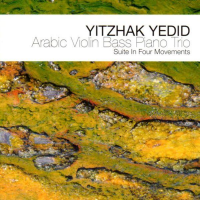Home » Jazz Articles » Album Review » Yitzhak Yedid: Arabic Violin Bass Trio: Suite In Four Movements
Yitzhak Yedid: Arabic Violin Bass Trio: Suite In Four Movements
This impressive suite, as in all Yedid's major compositions, consists of movements that suggest cinematic images, emotions and events that correspond with the variety of musical styles and contrasting compositional approaches and modes. These inter-textual elements have an accumulated effect on the narrative of this impressive suite. The differences>, for example, between the Arabic scales (the Maqamat), their forms of improvisation (the Taqsim) and the Jewish prayers and themes become dim and the similarities tangible.
The first movement fuses organically between Arabic music, its abstraction through brief, reserved improvisations and its influence and resemblance to Sephardi Jewish liturgical poems (Piyyutim). Yedid's trusty musical partners, double bassist Ora Boasson Horev, and Arabic violinist Sami Kheshaiboun, absorb the frictions between these cultures with elegance, sensitivity and grace.
The second movement is reverential and dramatic in its spirit as it was inspired by the prayers of Yom Kippur, the holiest and most solemn day in the Jewish calendar. The most impressive movement is the third. Here, Yedid begins with the distressing image of a "homeless Holocaust survivor on the streets of Tel Aviv" and concludes with the transformation of this image into a moral call for responsibility, empathy and community action, translated into a musical idea that merges Jewish prayer mode with Christian chorale that symbolizes an act of a congregation.
The fourth movement is lighter and consists of eight short and colorful sections. This movement summarizes all the musical elements manifested throughout the former movements into a joyful, optimistic and reconciling musical vision.
A highly poetic, personal and inspiring composition. Beautifully executed.
Track Listing
First Movement: Taqsim, dedicated to the day of tomorrow, The image of an old weary man, The pianist’s gaze, Poetic fractions, Evolution of hatred and bitterness, His final request; Second Movement: The High Priest’s whispered prayer on Yom Kippur as he leaves the Holy of Holies, The dancers’ gleeful cries, Olive branches in the candelabra, Belly dancing in an imaginary cult ritual, Eruption, “And thus would he count”, An even more powerful eruption, “One, one and one, one and two, one and three, one and four, one and five”: Third Movement: Image of a homeless Holocaust survivor on the streets of Tel Aviv, The double bassist’s voice, Awakening the dead, An Israeli chorale, dedicated to the Holocaust survivor: Fourth Movement: Cries of joy, The violinist’s gaze, Hallucinatory Debka dance, Magic of a sensual belly dancer, And again the cries, The image of the old man from the First Movement, The madness of creation, Epilogue: the prayer of purification.
Personnel
Yitzhak Yedid: piano; Sami Kheshaiboun: arabic violin: Ora Boasson Horev: double bass.
Album information
Title: Arabic Violin Bass Trio: Suite In Four Movements | Year Released: 2012 | Record Label: Between the Lines
< Previous
Ancestors
Comments
Tags
For the Love of Jazz
 All About Jazz has been a pillar of jazz since 1995, championing it as an art form and, more importantly, supporting the musicians who create it. Our enduring commitment has made "AAJ" one of the most culturally important websites of its kind, read by hundreds of thousands of fans, musicians and industry figures every month.
All About Jazz has been a pillar of jazz since 1995, championing it as an art form and, more importantly, supporting the musicians who create it. Our enduring commitment has made "AAJ" one of the most culturally important websites of its kind, read by hundreds of thousands of fans, musicians and industry figures every month.



















